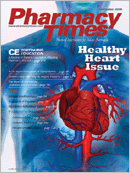Publication
Article
Pharmacy Times
A Pharmacist's Guide to OTC Therapy: Cholesterol Monitors
Author(s):
In the United States, approximately20% of adults have elevated cholesterollevels.1 That means, 1 in every 5 Americanadults has a cholesterol level of240 mg/dL or greater.2
Various risk factors may contribute toincrease the incidence of elevated cholesterollevels. Examples of these riskfactors include:
- Age and gender
- Familial history of early cardiovasculardisease
- History of diabetes
- History of hypertension
- Diet (high in saturated fats andcholesterol)
- Being overweight
- Sedentary lifestyle
- Smoking
Over-the-counterCholesterol Tests
As the number of individuals withhypercholesterolemia increases, theuse of home cholesterol tests is alsoon the rise. These testing kits assistmany individuals in monitoring cholesterollevels as a means of reducingtheir risk of developing cardiovascularproblems. Pharmacists arein a key position to make patients,especially those with cardiovascularrisk factors, aware of theoptions available for monitoringcholesterol levels at home. Whilethe majority of at-home cholesteroltests measure only total cholesterol(Table 1), a few tests also can measurelow-density lipoprotein cholesterol(Table 2), high-density lipoprotein cholesterol(HDL-C) (Table 3), and triglycerides(Table 4).
Patient Counseling
It is important for pharmacists tothoroughly counsel patients about theproper use of these tests. Prior to recommendingany of these tests, pharmacistsshould always determine if thepatient has any coagulation disorders oris taking anticoagulants, since the fingerstick could put such a patient at risk forexcessive bleeding. Therefore, the use ofat-home cholesterol tests is not recommendedfor these patient populations.They should be encouraged to seek theadvice of their primary health careprovider. Patients also should be advisedof certain factors that may interfere withthe results of these tests. Examplesinclude avoiding doses of 500 mg ormore of vitamin C, as well as avoidingacetaminophen or naproxen within 4hours of testing, since these factors mayinterfere with results.1 Individuals alsoshould be encouraged to have follow-uptesting with a physician if they have anyfurther concerns, especially if their totalcholesterol is 200 mg/dL or greater, theirHDL-C is 40 mg/dL or less, or theirtriglycerides are 150 mg/dL or greater.1
Encouraging patients to be knowledgeableabout their cardiovascularrisks, as well as informing them of measuresthat can decrease their risks, areother ways pharmacists can be indispensablein promoting good health. The useof at-home cholesterol monitors (exampleslisted in Table 5) empowers patientswith an easy tool that can be used to routinelymonitor cholesterol levels. It isimportant that pharmacists remindpatients to always follow up with theirphysician for more thorough testing.
Ms. Terrie is a clinical pharmacy writerbased in Haymarket, Va.
For a list of references, send a stamped, self-addressedenvelope to: References Department,Attn. A. Rybovic, Pharmacy Times, AscendMedia Healthcare, 103 College Road East,Princeton, NJ 08540; or send an e-mailrequest to: [email protected].

Newsletter
Stay informed on drug updates, treatment guidelines, and pharmacy practice trends—subscribe to Pharmacy Times for weekly clinical insights.






